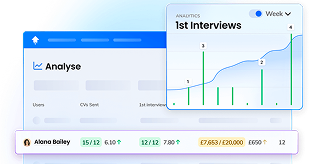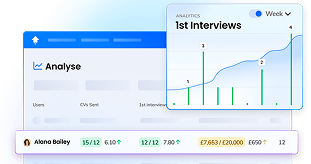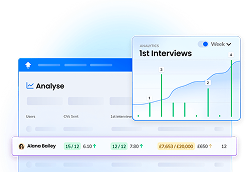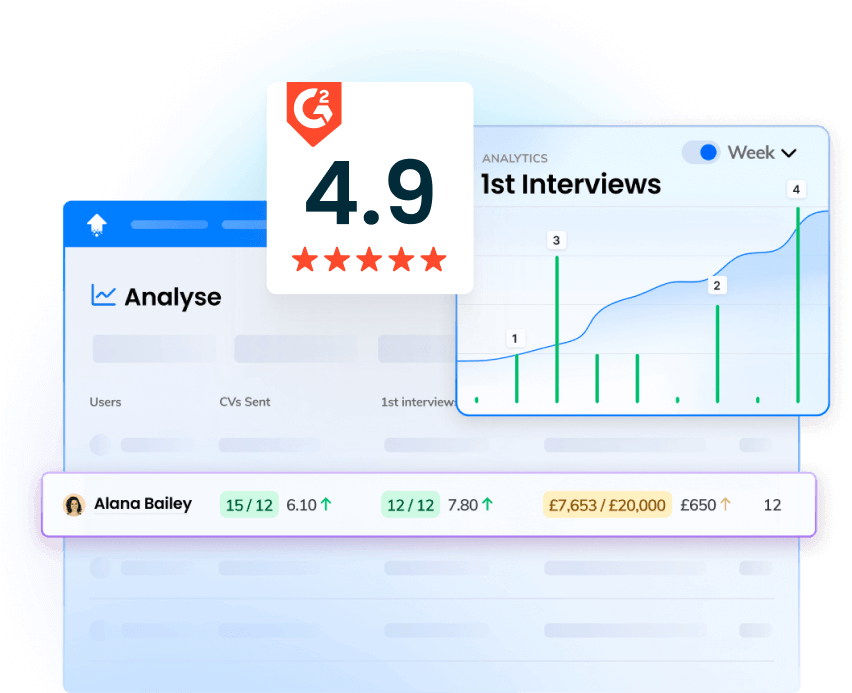Gamification is on the rise in recruitment.
By employing games throughout the talent acquisition process, recruiters are able to boost the candidate experience, save time, and ultimately hire better fits for each role.
Recruitment leaders can also improve team performance through gamification.
And in 2024, it’s more important than ever to enhance the hiring process.
Today’s candidates expect a seamless and engaging experience with feedback in real-time.
Meanwhile stretched agency clients demand talented staff who will hit the ground running and stay with the business.
Gamification can deliver on both fronts.
So what is gamification in recruitment?
Understanding Gamification
Gamification in recruitment benefits both candidates and recruiters.
To gamify their hiring process, recruiters essentially turn different stages of the recruiting process into a game or game-like scenario.
Not only does this make the candidate experience more engaging, interactive and fun than a traditional recruitment process, but it allows recruiters to put job applicants’ skills and experience to the test in a real-world context.
So how does gamification help recruitment agencies and recruiters?
As detailed above, gamification gives recruiters a more engaged pool of potential candidates who are enjoying a smoother user journey. But it can also help to boost their own performance.
Recruitment leaders use performance gamification tools to motivate their teams to hit goals and drive competition among colleagues.
They can also use gamification to encourage collaboration, boosting company culture in the process.
It makes the average workday a lot more fun for recruiters, too.
What’s more, recruiting gamification software empowers recruitment managers to create custom dashboards and leaderboards that clearly display teams’ and individuals’ progress towards their goals.
These can be displayed on prominent screens in the office to ensure targets are front of mind — and to foster a culture of healthy competition.
There are plenty of gamification elements on the market too, from collecting points, badges, and levelling up, to setting individual or group missions or competitions.
You can even celebrate with a personalised anthem for each recruiter when they hit a target!
Where Did Gamification Come From?
No matter how far back you turn the clock, you’ll find humans engaging with games.
The Scouts has been handing out badges to encourage positive actions or good behaviour since its formation in 1907.
Back in 776 BCE, the first ancient Olympic Games took place — complete with league tables — gamifying running, javelin, jumping, discus, and wrestling.
Want to travel further back still?
Archaeological evidence suggests humans gamed in prehistory. Senet is one of the earliest examples of a board game. This game was found in Egyptian burial sites dating back to 3500 BCE.
What’s more, it’s believed the first pair of dice were made over 5,000 years ago. They were carved out of bone.
So why are humans so drawn to game formats?
Ultimately, games tap into the very core of human nature — the need for encouragement, recognition, and adventure.
Onto gamification.
The term ‘gamification’ was coined in 2002 by designer Nick Pelling, who was creating game-like interfaces for commercial electronic devices such as ATMs and vending machines.
Then, in 2005 Rajat Paharia founded Bunchball — a platform designed to add gamification to websites to boost engagement. And in 2007 Kevan Davis developed Chore Wars, a fantasy role playing game designed to incentivise housework.
From 2009, gamification exploded into all areas of life. There was the launch of Foursquare — a popular social tool that rewarded visiting new places — and BigDoor, which introduced gamified customer loyalty solutions.
Gamification conferences and workshops popped up in the corporate world, and pioneering new innovations like the Fitbit, Pokemon Go, and Zombies! Run hit the market.
Meanwhile, existing platforms such as Snapchat, Mozilla, and Amazon added gamification elements.
In 2024, gamification is used widely in the corporate world, and has been proven time and time again to be a highly effective motivational tool.
Key Concepts in Gamification
Six design principles for corporate gamification were determined in a 2022 study.
These were:
- Rapid feedback
- Team competition
- Clear rules
- Goal-oriented challenges
- Integration with training goals
- Freedom to fail
The Role of Gamification in Modern Recruitment
Why use gamification in recruitment?
Because the advantages of doing so are wide-ranging.
In fact, it benefits almost every stage of the recruitment journey.
Read on for some of the biggest benefits to gamification in recruitment.
Improved Candidate Engagement
Effective gamification boosts candidate engagement — and makes for a much smoother applicant experience. So they’re more likely to stick with the process, which gives you a higher chance of placing them in a role.
Everyone wins.
To understand how gamification improves candidate engagement, just think back to the last time you applied for a job.
Did you enjoy it?
Barely anyone looks forward to filling in unending application forms, writing cover letters, or tailoring their CV to every role — no matter how much they want the job.
It’s dull, it’s uninspiring and it’s time-consuming.
And the documents recruiters end up with after such an arduous process may not even truly reflect how the candidate would really perform in the role.
Instead, treat candidates to a series of easy-to-understand games or game-like scenarios that will truly engage them, and leave them with a great impression of your recruitment agency and the employer.
Improved Recruitment Pipeline Efficiency
As a recruitment leader, you know which tasks are critical to a strong recruitment process.
The age-old question is — how do you get your recruiters to really focus on these tasks?
Gamification is an incredibly effective solution.
Through the use of tools such as OneUp, which facilitate cutting-edge gamification, leaders can incentivise their recruiters to hone in on the tasks that really matter — and smash their goals.
Set your team targets aligned with your goals, and build them into transparent custom dashboards to empower your team to take accountability for their own progress.
You can then run one-to-ones based on real-time data, and drill down into the reasons for both high and low performance.
Spark competition by setting reps challenges and missions based around their goals.
Now create leaderboards that show side-by-side performance of different recruiters or teams — and celebrate success with personal anthems when milestones or goals are hit.
Don’t forget to display these leaderboards on prominent screens around the office.
By getting your team to focus on the tasks that matter most to you — and incentivising them to work harder to hit their goals — gamification can significantly boost recruitment pipeline efficiency.
Elements of Gamification in Recruitment
So, how to use gamification in recruitment?
There are a variety of elements that must be considered before rolling out gamification within your recruitment process.
Game Mechanics
How are you going to structure your gamified recruitment process?
How best can you incentivise players?
What elements of gameplay will allow you to hit your goals?
First up, identify the goals you want players to hit.
If you’re looking at recruiter performance, these should tie into your agency’s wider goals.
For example, you might set them a SMART goal of bringing in £X amount of revenue between [start date] and [finish date].
For candidates, the goal might be to demonstrate X, Y, and Z skills or capabilities.
For an extra gamified element, you may also want to convert these goals into challenges.
So, instead of simply setting every recruiter a revenue goal, you might task them with collecting X number of points, and Y number of badges by your finish date.
These points and badges will of course correspond with passing milestones on the way to hitting their revenue goal.
You could also encourage competition by making it a head-to-head challenge or incentivise collaboration by turning it into a team goal.
So what common elements will you find within recruitment games?
Leaderboards are a classic element of gamification that works perfectly when you have multiple users competing against each other.
Set custom goals or competitions, and prominently display leaderboards in your recruitment agency office so all recruiters can track their progress — and that of their colleagues. Set up milestones and automate personal anthems or pre-recorded messages that play when a goal is reached.
Points and badges are another traditional gaming element that has proven effective in an agency setting.
Whether you’re setting up a classic head-to-head game, a job simulation trial, or a fully-immersive and illustrated quest, recruiters will naturally want to collect as many points as possible and receive badges along the way.
This keeps them engaged and incentivises them to carry out the desired behaviours.
Candidate-Centric Experience
In 2024, recruitment agencies must deliver a strong candidate experience that is memorable for all the right reasons.
Failing to do so can cause qualified candidates to lose trust in the recruiter or employer, and ultimately drop out of the process — decreasing the size and quality of your talent pool, and making it harder to place candidates.
All of which can damage your revenue stream.
Gamification works hand-in-hand with a smooth and seamless candidate experience. When choosing or designing your gamified recruitment system, consider the type of journey you want candidates to go on — and how you want them to feel throughout.
It’s essential to have a user-friendly interface. And it also needs to look good — a clunky or old-fashioned experience could dent a candidate’s trust in your agency.
Finally, gamification needs to be accessible and inclusive.
Here are some best practice tips:
- Use simple, clear language, and text formatting
- Allow users to play through text prompts at their own pace
- Provide a clear contrast between text and background
- Ensure interactive elements are clear and well spaced out
- Provide subtitles for speech
- Provide separate volume controls or mutes for sound effects, background music, and speech
- Do not make voice commands mandatory
- Ensure all text is clearly read out loud
Implementing Gamification in Recruitment
Sold on gamification?
Here’s a step-by-step guide on how to integrate it within your recruitment agency.
1. Evaluate your current recruitment process
Using data and feedback from both your clients' hiring managers and candidates, evaluate your current recruitment process, as well as your agency’s goals and client roster.
Consider:
- What are the strongest and weakest parts of your recruitment process?
- At what stage/s of the recruitment process could gamification be introduced?
- How can you create games that will help you meet your agency’s goals?
- How can you create games that will work for your client roster?
- What goals do your recruiters need to hit in order to get your agency where you want it to be?
2. Identify where you want to introduce gamification
Some agencies may want a complete overhaul of their recruitment process, and therefore choose a full-service platform that facilitates hiring from beginning to end — incorporating clever gamification along the way.
Others may be pretty happy with their current talent acquisition process, but want to introduce gamification at some stages to improve recruiter productivity.
Gamification can be used for:
- Recruiter motivation and performance
- Team collaboration
- The overall recruiting process
- Boosting the candidate experience
- Screening candidates
- Skills assessments
- Interviewing
3. Decide which types of games will work best for you
There’s a broad range of recruitment games to choose from.
Agencies may want to start with a simple yet motivational leaderboard, or progress to more creative incentives to drive performance.
The type of game or games you choose will depend on where you are planning to integrate gamification into the hiring process, as well as your goals and your client roster.
Here are some gamification recruitment examples for improving agency productivity:
- Head-to head challenges between reps
- Leagues based around specific metrics such as Interviews Booked
- Team collaborations to achieve big targets, such as quarterly revenue goals
- Incentives with special prizes, such as a team meal, when specific goals are met
For improving the candidate experience, gamification examples include:
- Quizzes to test areas of subject matter knowledge
- Team-based games to test how well player collaborate
- Races to test speed and efficiency
- Puzzles to assess problem-solving skills
4. Choose your gamification tool
There are a wide variety of gamification tools on the market, and the option you choose will depend on the type of game you want to create, your budget, and what area of the recruitment process you’re keen to gamify.
OneUp

Recruitment management platform OneUp is designed to create a high-performance culture driven by success.
Use its custom dashboards and leaderboards to focus your team on the activities that matter, drive accountability, foster healthy competition — and ultimately, motivate them to smash their goals.

You can build custom dashboards for individual reps as well as teams, tailored to targets that are aligned to your goals.
Leaderboards can be shared with all team members and displayed on screens across the office so all reps can track their progress in real-time.

Create leagues, challenges and missions when you want to encourage your team to compete or collaborate. And don’t forget to incentivise them!
You can also assign each rep a unique celebration anthem or broadcast for when they hit targets.
The Talent Games
Want to use gamification to improve the candidate experience?
The Talent Games offers both budget ready-to-play games and more expensive custom-built games with a tailored storyline and bespoke artwork.
These fun AI-powered pre-interview assessments promise to accurately evaluate a candidate’s cognitive ability, aptitude, and behaviour.
The tool works on an unbiased algorithm to reduce bias during the recruitment process too.
Owiwi
Elsewhere, Owiwi delivers captivating, immersive games. Players venture on an immersive journey, making choices along the way.
Through this process, recruiters gain valuable insights into a candidate’s character traits like accountability, integrity and adaptability, and soft skills like decision-making, people support, project management, and problem-solving skills.
This gives recruiters a better idea of how well the candidate would fit within the company culture, as well as how they would perform in the role.
Toggl hire
With Toggl hire, candidates apply via quiz-style skills assessments, and the scoring system simply shortlists top candidates.
Recruiters can choose from a vast library of ready-made quizzes already tailored to very specific job roles.
myInterview
So how can the interview process be gamified?
With myInterview, recruiters can set questions that candidates respond to in a one-way video. They can also include personalised video introductions to greet the candidate.
Recruiting teams can then review the videos and identify the candidates they want to take through to live interviews. Teamwork is made easy here, with the ability to comment and rate each video, and easily share them with clients.
Best Practices for Gamification Implementation
- Align your gamification with your wider goals
- Always define clear objectives for each game
- Understand the audience who will be playing the game
- Incorporate a real-time feedback loop
- Use realistic and relevant scenarios
- Include clear rules and expectations at the start of the game
- Provide a sense of progression
- Ensure your game/s are accessible to all
- Leverage data analytics to track performance and progress
- Ensure the game is playable on mobile and tablet as well as desktop
Measuring Success with Gamification
The ability to easily and accurately measure success in real time is one of the biggest benefits of gamification for recruitment agencies.
The first step is to develop the key performance indicators that will measure the success of each recruiter.
On the other hand, if your game is intended to increase the number of vacancies a recruiter on your team fills, your KPI may be that they fill X number of vacancies from Y date to Z date.
Once you’ve set your KPIs, you will need to decide how to measure them.
For most games this will be really simple, as the game itself is designed to test your KPIs. The platform you use should simply show you the results in real-time.
You can also set up custom dashboards to track each recruiter's progress towards their KPI, and show how their performance compares to their colleagues.
This will allow you to properly analyse each recruiter’s strengths and weaknesses.
Final Thoughts
Gamification already plays a sizable role in the recruitment processes of forward-looking clients and agencies.
As technology develops and more businesses embrace gamification for recruitment, we can expect to see a monumental shift in both the quality of hires and where recruiters spend their time.
The message is clear: recruitment leaders can’t afford to ignore the gamification revolution.
After all, not only does it help you make better hiring decisions — but it helps you get the most out of your team too.
Keen to adopt gamified recruitment? Why not motivate your team with OneUp?
This recruiting gamification software empowers you to create custom dashboards, leaderboards, challenges, missions and more to put your team firmly on the path to success. Book your demo here.




















